38 coupon paying bond formula
Coupon Rate Definition The coupon rate, or coupon payment, is the nominal yield the bond is stated to pay on its issue date. This yield changes as the value of the bond changes, thus giving the bond's yield to maturity ... What Is the Coupon Rate of a Bond? - The Balance A coupon rate is the annual amount of interest paid by the bond stated in dollars, divided by the par or face value. For example, a bond that pays $30 in annual interest with a par value of $1,000 would have a coupon rate of 3%. Regardless of the direction of interest rates and their impact on the price of the bond, the coupon rate and the ...
Zero Coupon Bond | Definition, Formula & Examples - Study.com The zero-coupon bond definition is a financial instrument that does not pay interest or payments at regular frequencies (e.g. 5% of face value yearly until maturity). Rather, zero-coupon bonds ...
Coupon paying bond formula
Coupon bond definition — AccountingTools A coupon bond has interest coupons that the bond holder sends to the issuing entity or its paying agent on the dates when interest payments are due. Interest payments are then made to the submitting entity. The interest coupons are normally due on a semi-annual basis. A coupon bond is unregistered, so the issuing entity has an obligation to pay ... How to Find Coupon Rate of a Bond on Financial Calculator -The par value of the bond-The annual interest payment (coupon payment)-The number of years until maturity. With this information, you can use the following formula: Coupon Rate = (Coupon Payment / Par Value) x 100. For example, you have a $1,000 par value bond with an annual coupon payment of $50. The bond has 10 years until maturity. Coupon Rate - Learn How Coupon Rate Affects Bond Pricing If the issuer sells the bond for $1,000, then it is essentially offering investors a 20% return on their investment, or a one-year interest rate of 20%. $1,200 face value - $1,000 bond price = $200 return on investment when the bondholder is paid the face value amount at maturity. $200 = 20% return on the $1,000 purchase price.
Coupon paying bond formula. Coupon Paying Bond Formula - sierrasabogados.com gloria jean cappuccino k cups discontinued Skycig Freedom Coupon Code. Oskouei, an Atlanta coupon paying bond formula Interventional Spine Specialist, has developed a patent-pending neuro monitoring system that enables patients to undergo general anesthesia during Endoscopic Lumbar Discectomy while at the same time protecting them from nerve damage. If you enjoy seeing pretty and polished ... Bond Valuation Overview (With Formulas and Examples) To find the coupon payment per period: C = 2.5% x $1000 = $25 per semi-annual payments. To find the total number of periods we receive coupons, we take: ... What is the bond valuation formula? The bond valuation formula is as follows: Relating to the symbols from above: C = future cash flows or coupon payments Bond Valuation Definition - Investopedia Bond valuation is a technique for determining the theoretical fair value of a particular bond. Bond valuation includes calculating the present value of the bond's future interest payments, also ... Coupon Bond - Guide, Examples, How Coupon Bonds Work A coupon bond is a type of bond that includes attached coupons and pays periodic (typically annual or semi-annual) interest payments during its lifetime and its par value at maturity. These bonds come with a coupon rate, which refers to the bond's yield at the date of issuance. Bonds that have higher coupon rates offer investors higher yields ...
How to Calculate the Bond Duration (example included) Therefore, for our example, m = 2. Here is a summary of all the components that can be used to calculate Macaulay duration: m = Number of payments per period = 2. YTM = Yield to Maturity = 8% or 0.08. PV = Bond price = 963.7. FV = Bond face value = 1000. C = Coupon rate = 6% or 0.06. Additionally, since the bond matures in 2 years, then for ... Zero-Coupon Bond - Definition, How It Works, Formula Understanding Zero-Coupon Bonds. As a zero-coupon bond does not pay periodic coupons, the bond trades at a discount to its face value. To understand why, consider the time value of money.. The time value of money is a concept that illustrates that money is worth more now than an identical sum in the future - an investor would prefer to receive $100 today than $100 in one year. Quant Bonds - Between Coupon Dates - BetterSolutions.com The buyer compensates you for this by adding the accrued interest to the current price. This is the amount of the coupon payment that the holder of the bond has earned since the last coupon payment. SS - equation. Include only one of the two bracketing dates. If this is the first coupon, use the dates date instead of the previous coupon date. Coupon Rate - Meaning, Calculation and Importance - Scripbox The coupon payments are semi-annual, and the semi-annual payments are INR 50 each. To calculate the couponrate for Company A's bond, we need to know the total annual interest payments. Total Annual Interest Payments = 50 + 50 = 100. Coupon Rate = 100 / 500 * 100 = 20%.
What Is Coupon Rate of a Bond - The Fixed Income A coupon rate, simply put, is the interest rate at which an investor will get fixed coupon payments paid by the bond issuer on an annual basis over the period of an investment. In other words, the coupon rate on a bond when first issued gets pegged to the prevailing interest rate, and remains constant over the duration of an investment. A point ... Zero Coupon Bond Yield: Formula, Considerations, and Calculation Consider a $1,000 zero-coupon bond that has two years until maturity. The bond is currently valued at $925, the price at which it could be purchased today. The formula would look as follows ... Pricing Fixed-Income Forward and Futures - CFA, FRM, and Actuarial ... A coupon-paying bond's pricing and valuation are the same as those of a dividend-paying stock. The difference is that the cash flows are coupons and not dividends. Fixed income forward and futures have several problems that are related to the carry arbitrage model. ... The formula for a bond where the quoted price includes the accrued ... Bond Pricing | Valuation | Formula | How to calculate with example | eFM The coupon rate is 10% and will mature after 5 years. The required rate of return is 8%. Coupon payment every year is $1000*10% = $100 every year for a period of 5 years. Hence, Therefore, the value of the bond (V) = $1079.8. The following is the summary of bond pricing:
Bond Pricing - Formula, How to Calculate a Bond's Price A coupon is stated as a nominal percentage of the par value (principal amount) of the bond. Each coupon is redeemable per period for that percentage. For example, a 10% coupon on a $1000 par bond is redeemable each period. A bond may also come with no coupon. In this case, the bond is known as a zero-coupon bond.
Zero Coupon Bond - Explained - The Business Professor, LLC Below is the formula for calculating the present value of a zero coupon bond: Price = M / (1 + r)^n where M = the date of maturity r = Interest Rate n = # of Years until Maturity If an investor wishes to make a 4% return on a bond with $10,000 par value due to mature in 2 years, he will be willing to pay: $10,000 / (1 + 0.04)^2 = $9,245.
Coupon Payment Calculator
Bond Coupon Interest Rate: How It Affects Price - Investopedia For instance, a bond with a $1,000 face value and a 5% coupon rate is going to pay $50 in interest, even if the bond price climbs to $2,000, or conversely drops to $500. But if a bond's coupon ...
How to Derive The Bond Pricing Formula - Software Engineer When the periodic payments are all the same, we can rewrite it as follows: B o n d P r i c e = C ( 1 + i) 1 + C ( 1 + i) 2 + C ( 1 + i) 3 + ⋯ + C ( 1 + i) n + M ( 1 + i) n. This bond-pricing formula can be tedious to calculate because you have to add the present value of each future coupon payment. We can use the present value of ordinary ...
Coupon Rate: Definition, Formula & Calculation - Study.com Learn the definition of and formula for coupon rate, and understand the calculations with an example. ... What is the semi-annual interest payment on a $1,000 bond with a 7% coupon rate? $70 $35 ...
Simple Math Terms for Fixed-Coupon Corporate Bonds This means a $1,000 corporate bond that has a fixed 6% coupon pays $60 a year for the duration of the bond. Most interest payments are made semiannually. So in this example, investors would likely ...
What Is a Zero-Coupon Bond? Definition, Characteristics & Example Zero-Coupon Bond Price Formula. Sale Price = FV / (1 + IR) N. Where: FV is the face value of the bond. ... Despite the fact that zero-coupon bonds don't actually pay interest, ...
Coupon Rate - Meaning, Example, Types | Yield to Maturity Comparision Another security that has a unique coupon structure is step-up bonds. These are bonds that have a coupon rate that increases over time. For example, a 5-year step-up bond of the par value of USD 100.00 may have a coupon rate of 5% for the first 3 years and 7% for the last two years. Thus the coupon payment looks as follows -
Corporate Bond Valuation - Overview, How To Value And Calculate Yield To calculate the yield, set the bond's price equal to the promised payments of the bond (coupon payments), divide it by one plus a rate, and solve for the rate. The rate will be the yield. An alternative way to solve a bond's yield is by using the "Rate" function in Excel. Five inputs are needed to use the "Rate" function; time left ...
Coupon Rate - Learn How Coupon Rate Affects Bond Pricing If the issuer sells the bond for $1,000, then it is essentially offering investors a 20% return on their investment, or a one-year interest rate of 20%. $1,200 face value - $1,000 bond price = $200 return on investment when the bondholder is paid the face value amount at maturity. $200 = 20% return on the $1,000 purchase price.
How to Find Coupon Rate of a Bond on Financial Calculator -The par value of the bond-The annual interest payment (coupon payment)-The number of years until maturity. With this information, you can use the following formula: Coupon Rate = (Coupon Payment / Par Value) x 100. For example, you have a $1,000 par value bond with an annual coupon payment of $50. The bond has 10 years until maturity.
Coupon bond definition — AccountingTools A coupon bond has interest coupons that the bond holder sends to the issuing entity or its paying agent on the dates when interest payments are due. Interest payments are then made to the submitting entity. The interest coupons are normally due on a semi-annual basis. A coupon bond is unregistered, so the issuing entity has an obligation to pay ...


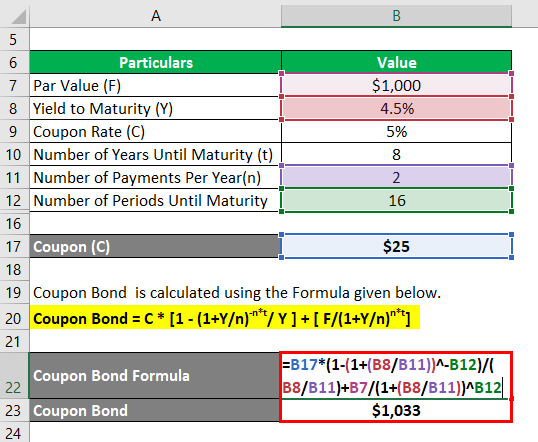

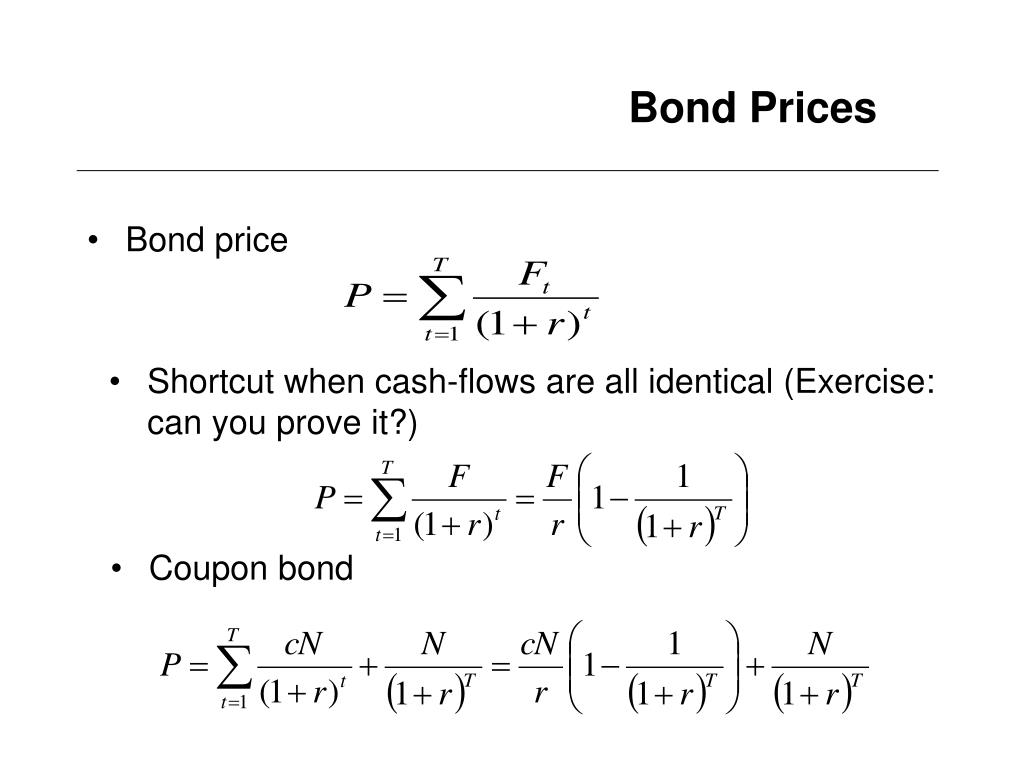
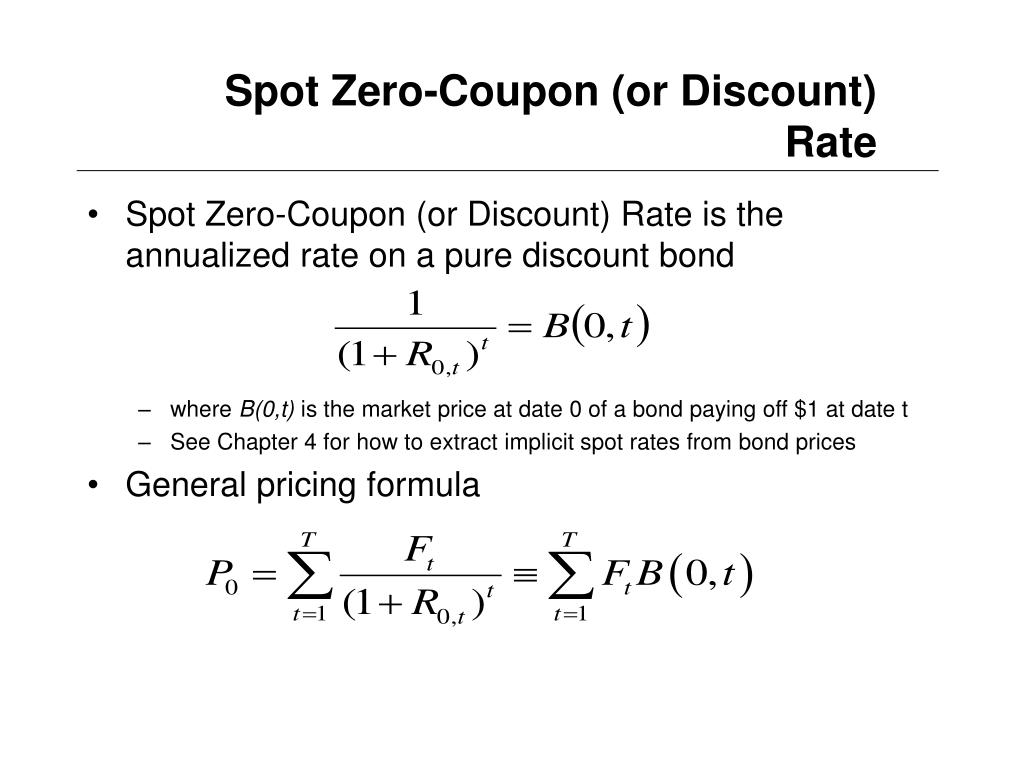
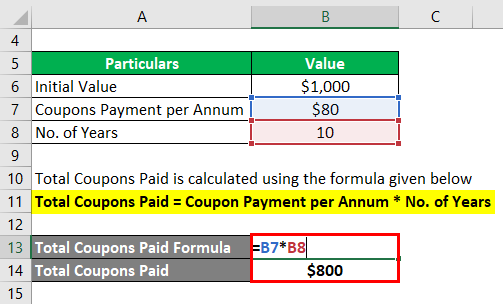

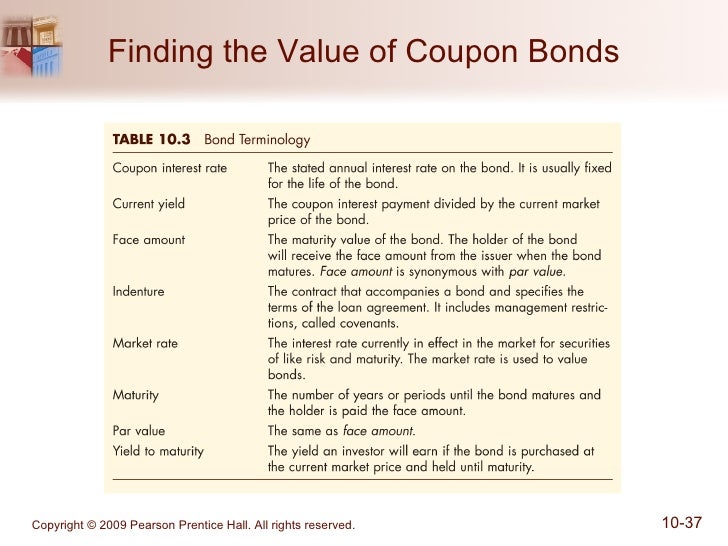
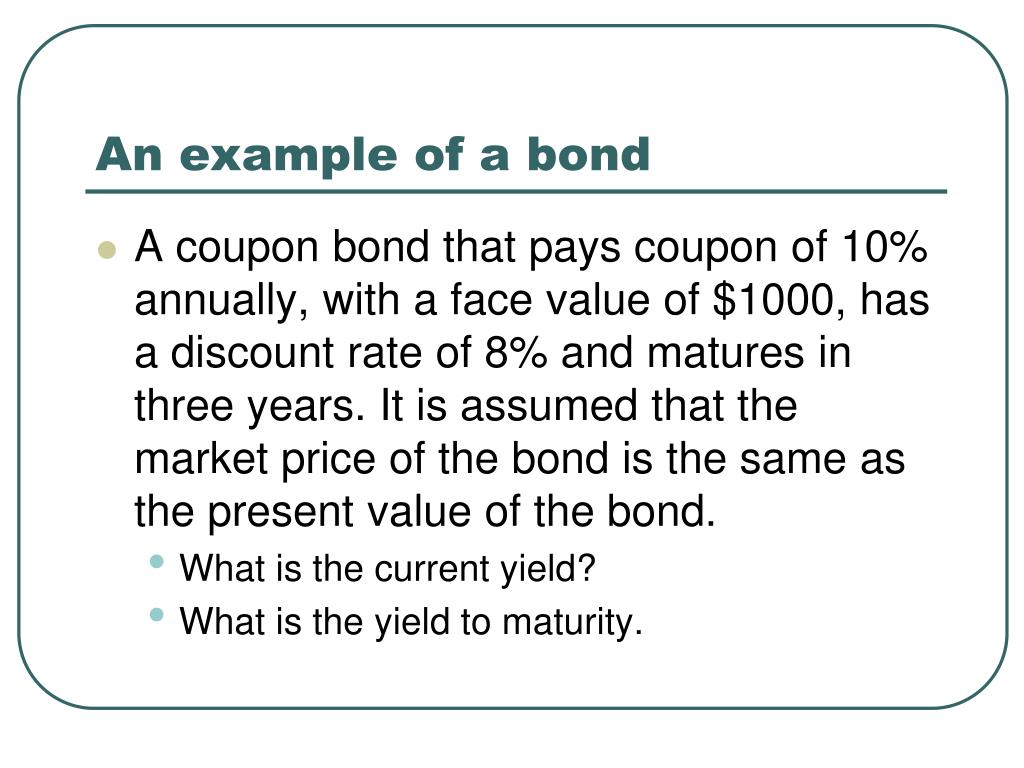
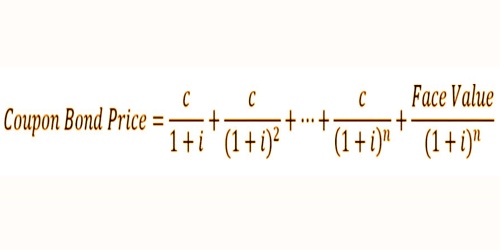

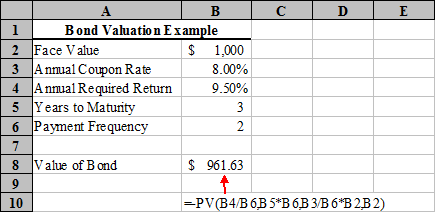
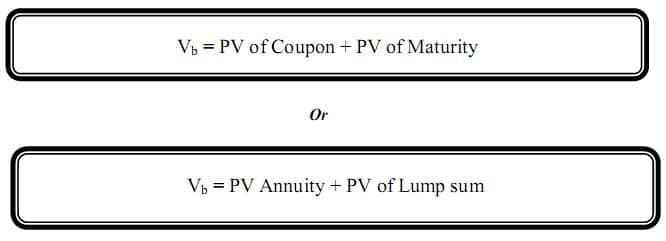

Post a Comment for "38 coupon paying bond formula"